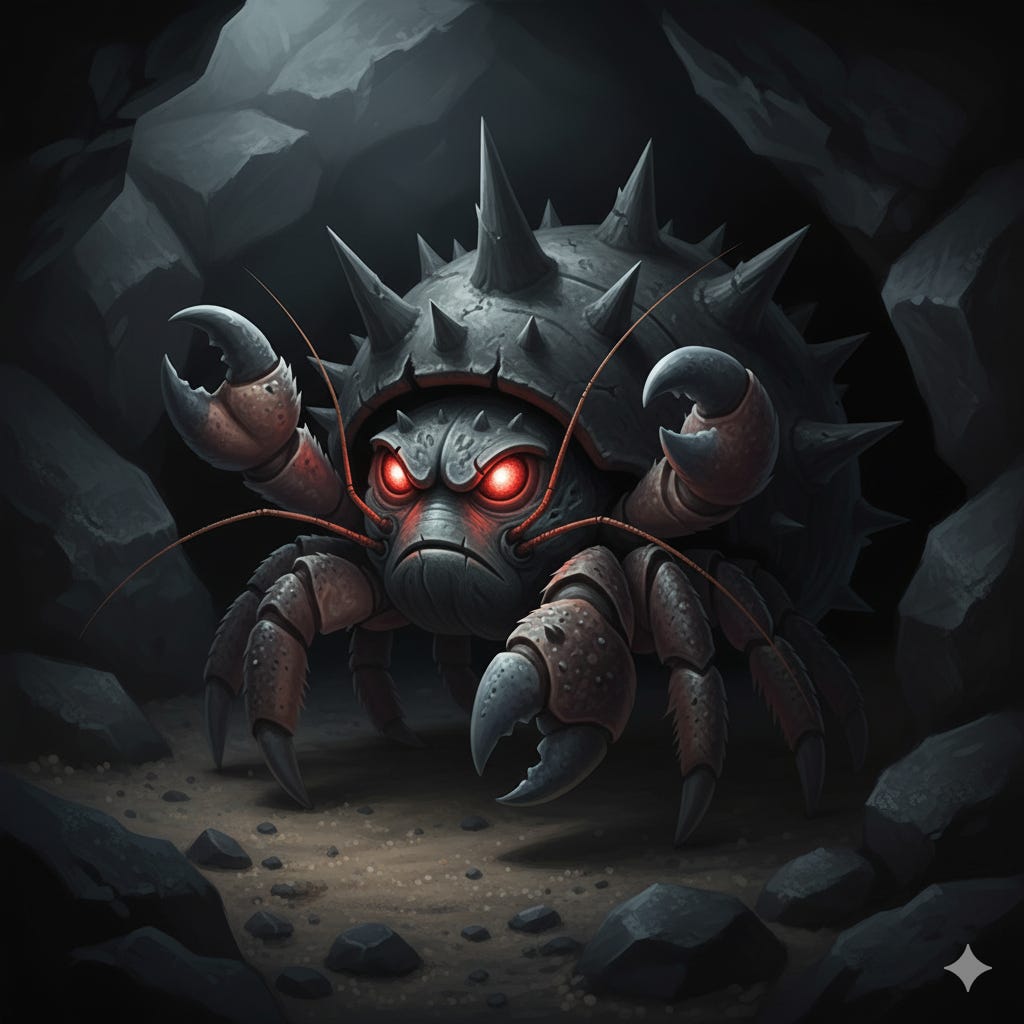The Narcissistic Spectrum
Pathological narcissism is a fortress built against unbearable pain. Some fortresses are sculpted from glass, some hewn from granite. My six-tier spectrum elucidates these architectures.
Pathological narcissism can take countless shapes depending on the relative strengths of all the stabilizing and destabilizing factors: My previous article lists these factors. I will reference it frequently in this one.
My chosen metaphor is that of a fortress, which represents the protective purpose of the false self. Other metaphors that I considered were that of hermit crabs who find shells of different materials (some smooth, some spiky) to protect themselves, or that of a diving suit that is vital for a diver underwater but needlessly restricts them on land. I’ve chosen the crab for the illustrations because cute.
A single person with narcissistic personality disorder – I’ll call them a castellan – usually finds themselves somewhere on this spectrum from delicate to robust – from glass fortress to fortified barbican – but they will likely move up and down slightly in different phases of their life.
These fortresses defend against persecutory introjects, which I’ve described in more detail in my article on the sadism spectrum. Introjects can be friendly, but the ones relevant here are persecutory ones that form an “alien self.” You can also think of them as a form of complex PTSD, where traumatic conditioning systematically shapes the kinds of trauma responses that the parent (or bully or school system etc.) wants to see.
Healing works differently for everyone, and a sudden drop from higher to lower tiers should be avoided if at all possible. Healing should feel like an exciting journey to discover more effective ways to get things done and to become more resilient. It should feel empowering. It should prevent collapse, not precipitate it. It will involve grief though.
Note that the following six points on the continuum are fairly arbitrary. One can imagine many other combinations of stabilizing and destabilizing factors (see my previous article) leading to many other presentations. The lower tiers have little control over themselves while the higher tiers are increasingly restricted in their thinking and acting by their own draconian rules. The lower tiers easily collapse into vulnerable states due to difficulties but recover quickly, while the higher tiers collapse into vulnerable states rarely and then often permanently, e.g., due to aging.
Let’s walk through this progression, from the unstable foundations of BPD, where there is no fortress (no NPD) yet, over the invisible glass fortress, to the barbican with embrasures in all directions.
Tier 0: Borderline Personality Disorder (BPD) – The Raft in the Storm
Core dynamic. “My self shatters from one moment to the next. I’m everything and nothing.”
Fictional example. Clementine Kruczynski in Eternal Sunshine of the Spotless Mind.
Upbringing. Here a parent fell short in particular on the marked side of the contingent marked mirroring: Psychodynamic theory has it that a child learns the self when it experiences things, and the parent mirrors them back to the child (contingent mirroring) in a way that clarifies that these are to be considered the child’s experiences and not the parent’s experiences (marked mirroring).
If a child cries, a regular parent reacts in a way that recognizes the crying, and then reacts to it with reassurances or by removing whatever is causing the discomfort. A less capable parent might get triggered by the crying because it reactivates traumas around despair, and might start screaming and smashing doors in a symbolic attempt to escape. That’s terrifying for the child and completely unhelpful for the development of the self. (By the way, many of these insights are based on the work of Heinz Kohut.)
I have the pet theory that neurodevelopmental issues like autism can disrupt the formation of the self even when the parent is good enough. All the sensory input may be overwhelming for such a child. They might have trouble reading their parent’s facial expressions and tone of voice. Perhaps holding them is the only way to signal to them that the parent is there for them, but then tactile sensory issues might make that painful too. Other genetic factors surely also play a role.
Permanent changes in who the caregiver is – say, different nannies or grandparents or none at all at an orphanage – feel like devastating losses of a parent to the child, which can also be disruptive, especially when it happens after the child is already six weeks old.
The presence of even one emotionally attuned adult in the household can make a huge difference even if they’re not the primary caregiver. If the duty to raise the child is shared among more people, the chances are higher that the child will have a person like that among them. Sadly, that is not how families work in WEIRD cultures.
Finally, the factor of collective effervescence can potentially forestall the development of personality disorders as they present in adulthood.
Presentation. The result is, for example, an adult who is constantly in the throes of emotional chaos, feelings of emptiness, and a desperate, often self-destructive search for an identity to absorb. Relationships are intense, unstable, and marked by a frantic oscillation between idealizing a person as a savior and devaluing them as a tormentor. Narcissistic traits may appear in fleeting moments – a flash of entitlement, a brief fantasy of greatness – but they are quickly washed away by the next tidal wave of emotional dysregulation. There are no lasting narcissistic traits present.
Imagine your livelihood depends on a job, but it a really dysfunctional company where you have five managers who never let you work on any one task for more than a few hours before another manager interrupts you with another super urgent but completely contradictory task, and the managers never talk to each other. Sometimes there’s a task you’re so good at that you can almost complete it, but you get interrupted anyway.
Functional recovery. Many of the problems of BPD are self-perpetuating. Behavioral interventions like dialectical behavioral therapy (DBT) can break these cycles (one year can make a huge difference), and psychodynamic interventions like mentalization-based treatment (MBT) can provide some of the reparenting that makes up for the deficits from childhood (usually more than two years).
Tier 1: BPD with narcissistic traits – The Ruins of the Fortress
Core dynamic. “My self shatters from one moment to the next. Maybe I deserve it. But how can I deserve this if these idiots over there are even worse and don’t even know it?”
Common stabilizing factors. Primitive defenses, impaired reality-testing, impaired empathy and mentalizing when triggered, substance use.
Common destabilizing factors. Failure/rejection, emotional attachments, emotional upset, societal attachment, moments of self-awareness, empathy, often depressive temperament, often values like honesty.
Fictional example. Benji in A Real Pain. He’s the loser in his adulting competition with David but manages to dominate David with specific social skills that David lacks and by attacking David’s fragile false self. He can find a temporary refuge in these skills. He tries the same with the tour guide when he feels threatened by him, but the guide is less reactive than David.
Upbringing. These castellans have had an emotionally chaotic parent or some other disruption in the formation of their self – see above. But they’ve also incorporated some systematic expectations on their performance from a parent, peers, the school system, or society in general. Persecutory introjects, as mentioned in the introduction.
So not only were they rarely understood by anyone, they were also systematically misunderstood to the point where they’ve started to hate and try to disown parts of themselves. This can be exacerbated by genetic temperamental factors and their wider social environment, as for tier 0.
Presentation. They were never able to achieve the success in life that could’ve sustained a false self; neither are they psychotic enough to fool themselves into thinking that they did. One of Benji’s claims to fame is his ability to influence groups and crowds and make things happen. He’d thrive as a famous motivational speaker or as a politician. But, alas, he’s neither, so he cannot find shelter in this chronically collapsing false self, this ruin of a fortress, for more than a few days at a time.
Imagine you work for the same chaotic company, but sometimes you get a task that is fun and that you’re good at, and you feel defiant and ignore all the other managers for a while until you manage to complete it. It doesn’t happen often, and it doesn’t last long, but what a reprieve it is anyway!
Functional recovery. These false selves are probably no obstacle in therapy, so treatments for BPD like DBT and MBT should work just as well.
If it’s any consolation, I’ve run a Facebook poll asking which type of NPD is hottest, and 40% voted for “BPD with narcissistic traits,” followed by “A healing Cluster B taking their fucking life back” (17%) and “NPD with overt vulnerability and grandiosity” (10%). So vulnerability and healing are hot! (Though arguably many of them simply picked their own presentation.)
Tier 2: Double-Covert NPD – The Glass Fortress
Core dynamic. “If I work hard, never make mistakes, and never misbehave, maybe I will become worthy of love?”
Common stabilizing factors. Success, avoidance, the enabling system of capitalism that rewards diligent productivity with mid-range stable salaries, “quiet” defenses (e.g., silent resentfulness and passive-aggression rather than outward blame-shifting), substance use (stimulants, anxiolytics, antidepressants), alexithymia.
Common destabilizing factors. Safety (downstream of financial safety), rejection (resentment because they think no one would dare to reject them if they didn’t always act so perfectly virtuous), failure (to be perfectly virtuous), illness and aging, depressive temperament, Light Triad traits, honesty, moments of self-awareness.
Fictional examples.
Sam Lowry in Brazil. This one is particularly impressive because you experience the movie from his perspective. His false self falls to ruins (tier 1) as he descends more and more into psychosis over the course of the movie.
David in A Real Pain. Dr. Mark Ettensohn argues that he’s on the neurotic level, so we’re seeing a personality style here, not a disorder.
Upbringing. As kids these castellans might’ve displayed anger but were steamrolled with disrespect; they might’ve displayed vivaciousness but were told to behave; they might’ve suppressed any self-expression and were praised for being perfect. Or they were praised for not being like their sibling. Or they watched movies where the villain showed these character traits.
Presentation. They were taught hard standards that they must never fall short of – often standards of propriety, decorum, modesty, obsequiousness, or diligence. When they observe someone’s boisterousness, vivaciousness, anger, spontaneity, or irreverence, it fills them with envy or disgust but also makes them feel more virtuous. They would love to be that person, but they cannot be close to them for fear third parties might make an association between them and these character traits. Both their anger (vulnerability) and their irreverence (“whimsical grandiosity”) are covert – hence the metaphor of the glass fortress which is fragile but also hard to see. They tend to score low on exploitativeness and high on self-sacrificing self-enhancement on the PNI. They’ll probably get diagnosed with social anxiety, OCD, AvPD, or OCPD before NPD.
Imagine you work for the same chaotic company, but as it happens, no one else wants to do the accounting. You also don’t like accounting, but you realize that it’s an opportunity to wrest back some control, because either they leave you in peace doing your accounting and nothing else, or they’ll have to do the accounting some of the time. You make it known that you’re the accounting person, and your plan works. No one fights you for the job, the managers stop trying to give you unrelated tasks, and you can lock yourself in your office and hope that no one notices that you kind of suck at accounting and are bored out of your mind.
Self-deceptions. If someone has managed to erect a fortress like this, they must be somewhat successful in life, extremely avoidant, or excellent at self-deception. Usually a combination. It takes great perfectionism, rigid self-control, and a careful avoidance of countless everyday situations (parties, karaoke, clubs, etc.) to maintain it.
Unmet needs have to either be denied or devalued, which can be reframed as a virtuous sacrifice, or they have to be framed as an injustice committed against them. These castellans have to be downright paranoid to avoid being drawn into conversations that touch on personal topics that would put them in the unpleasant double bind that they’d either have to unvirtuously lie or indecorously storm out so not to have to even think about how they think.
A minor mistake or an accidental rule-break is not a simple error; it’s a catastrophic event that threatens to shatter the entire glass fortress, triggering panic and elaborate internal blame-shifting. Their vulnerability is much more likely to become overt in such cases than their delicate grandiosity as they retreat more deeply into avoidance or displays of self-flagellation.
The irony of considering oneself among the most modest people who’ve ever lived is not lost on them, so self-contradictory values like that make it hard for these castellans to ever fully inhabit their grandiose states. If they do, and especially if others catch them in the act, they may feel exposed and subsequently shun these others and hope they’ll forget it ever happened.
Functional recovery. This presentation is probably not considered to be NPD by many diagnosticians, because it’s not associated with many of the clichéd behaviors of grandiose NPD. Hence it’s difficult for these patients to receive targeted support and guidance. They might be treated for social anxiety or OCD instead.
If they are more on the vulnerable side, they’ll seek and enjoy therapy without having to first suffer any kind of collapse. That’ll make the therapy process a continually rewarding experience and keep them engaged. However, if they were conditioned to be modest, they might think that seeking therapy is immodest because it implies that they think they deserve to feel better, and hence refuse it. Or they may be afraid to “fail” therapy and avoid it for that reason.
If they are more on the grandiose side, it may be just as hard for them to seek therapy as it is for tier 3 castellans, because neither of them can see themselves as flawed. If it does happen, the therapist will have a harder time noticing the devaluation – e.g., the castellan may ask questions about the private or professional life of the therapist in an effort to help the therapist and flip the script.
Most likely, they’ll flip between the states. Perhaps financial straits force them to work a job that they consider to be humiliating. They’re afraid to be seen at it, and try to be late and tardy a lot to signal that the job is beneath them. When that leads to negative feedback and threats that they might lose the job, the vulnerability becomes more apparent and they might feel targeted and seek to uncover who is secretly conspiring against them.
These castellans will probably enjoy the recovery process almost as much as those who are in predominantly vulnerable states, since even the grandiose states are driven by fairly conscious anxiety that can be reduced over the course of the treatment.
Tier 3: Grandiose NPD – The Stone Fortress
Core Dynamic. “If I make Forbes’ 30 Under 30, I can’t be unworthy, right?”
Common stabilizing features. Unsafe environment, success through superiority, primitive defenses, impaired reality-testing, hypomanic temperament, substance use, impaired empathy and mentalizing when triggered, alexithymia, interpersonal avoidant attachment.
Common destabilizing features. Illness, aging, humanism, rationality, emotional attachments, emotional upset, moments of self-awareness.
Fictional examples.
Metaphorically: Ender Wiggin in Ender’s Game has good reality-testing but is tricked into doing great harm. Waking up from self-deceptions feels similar to waking up to such an external deception.
Marvel: Tony Stark and Dr. Strange before their collapses. You can mine the Vicariously Ambitious, Stage Mom, and My Beloved Smother pages on TV Tropes for more examples.
Rumi in Demon Hunters.
Upbringing. These castellans were taught to achieve. When they felt weak, their parents misunderstood them by seeing only greatness in them, or they punished them by withdrawing their affection. When they won and achieved, they could earn brief affection. Perhaps they had as many siblings as their parents claimed to have cars (but they were all rentals), so they could earn affection only if they out-competed them all. Their parents probably paraded them around at age 5–8 or so to brag with how smart they already are: “Now show your auntie that new chess opening you developed! … Outstanding! So much smarter than your scapegoat sister!”
Presentation. Imagine you’ve worked for a less chaotic company for a while, and now the forces that be have put you in charge of a whole department. They selected you for the job because you already have a few months of experience in the particular subfield, but no one else in your department does.
You hold a bunch of meetings to impart your wisdom, and everyone listens to your every word. It feels amazing to be heard for once!
Sadly, after a few days, you’re done transmitting your experience from the previous months. You cobble together a few more dozen slides to enjoy the state for just a bit longer. This goes beyond what you actually have experience with, but at least your design and presentation are impeccable.
Someone raises their hand: “But wouldn’t lemurs have trouble with regular-sized toilet seats because their butts are so tiny?” “Of course not,” you say and shake your head in bewilderment. You move on quickly and try not to notice any raised hands to avoid more stupid questions. Neither did you notice that for a second you were afraid that oversights like that might cost you the respect that you enjoy so much.
Self-deceptions. Achievement is usually antithetical to avoidance, so without this invaluable shield at their disposal, these castellans have to double down on many other defenses instead. Often they are actually gifted, so they can work their way up until they’re among equals or aging takes its toll on their cognitive abilities. Then the going gets tough.
But there are many others tricks. Not tracking the performance of investments or not benchmarking them against broad low-risk market indices helps to obscure losses. So does making deals only with the sorts of sharks who’ll screw you over while making it look like you won.
If you piss people off and they request to be transferred to a different department, you can pretend that they just did want to constantly feel so envious of you. If your personal rival beats you in the professional sphere, you can focus on your better health or greater romantic success like a proper data dredger.
If you get triggered and the fight response kicks in, it’s your partners fault for causing you to freak out, or if your business fails, it’s the IRS’s fault for being so greedy. Finding all of these excuses in real time is stressful, so in these vulnerable moments, paranoia can sneak in again to try to avoid having to face them in the first place.
Some manage to split on themselves so effectively that memories of all sorts of failures are fully irretrievable so long as they’re in a grandiose state. Others even manage to overwrite their bad memories with fabricated ones.
This self-splitting is an interesting feature when viewed in the context of a competition against a rival where it can be a bit like a seesaw: If the rival does better, the walls against self-devaluation weaken and vulnerability peeks through. If the rival does worse, the grandiose split is easier to maintain.
Depending on another person is kryptonite too. We all have needs, sometimes unfulfilled needs, but our castellans can’t bear the feeling of dependency that comes with that because they never had a parent who taught them that it was safe to trust. Needing means requesting, but requesting exposes their intense rejection sensitivity. Hiding needs in the sturdy safe of entitlement gives them an excuse to disguise their rejection sensitivity behind righteous anger. Or they get rich so they can get almost anything they need for money without having to ask.
Relationships. Romantic relationships are hazardous for our castellans. They have to believe that they’re right and have a right to everything that they do and want, but all the rightness in the world doesn’t protect them from hurting their partners. That is doubly upsetting, (1) because they hypothetically can feel for their partners and have to constantly find creative solutions to excuse their behavior and blame-shift to not actually feel ashamed of hurting them, and (2) because these frictions ruin the fantasy that they’ve found their ideal partner: If they aren’t flawed, their partner must be flawed, and they cannot tolerate being (and being seen) with a flawed partner.
Chances are they’ll prefer to bite the fictional bullet that they’ve been betrayed by a partner who pretended to be perfect and whose mask eventually slipped than to acknowledge that they brought out all-too-human behaviors in them with their own frustrating behavior and just chose to label them as flaws as a false self defense.
Their upset over the imagined betrayal fuels enough rage that they can swiftly break up with the partner. Whenever doubts crop up whether the betrayal had actually been real, they assuage them by convincing mutual friends of their self-deceptions. If they can convince a mutual friend, they must be right. It’s not intended as a smear campaign, but has exactly that effect.
A different kind of seesaw can show up in romantic contexts too where it’s easy for them to relatively debase themselves toward an idealized partner because being lesser than such a perfect angelic being is irrelevant, and the approval of that being elevates them over the rest of the world. But when cracks start to show in the idealization, not only is that elevation by association no longer possible, but it even becomes necessary to gain superiority over the fallen angel to not be dragged down with them.
It’s like Icarus and Daedalus, except like a tandem skydive where only one of them has (and then loses) the wings.
Functional recovery. Dr. Ettensohn confirmed in an interview that in his experience the general impression is sadly true that these castellans usually tend to seek therapy only during or after their collapse. That is sad, because with MBT, the collapse might’ve been prevented.
These castellans are most readily diagnosed with NPD and NPD only, so studies like Vater et al. (2014) shed light on their rate of recovery (53% remission after 2 years). The handbook Mentalization-Based Treatment for Pathological Narcissism contains vignettes of treatment successes over the course of 4 years.
Tier 4: NPD with Antisocial Traits – The Sovereign’s Fortress
Core dynamic. “I enjoy nothing more than to snipe all the NPCs!”
Common stabilizing features. Sadism, Machiavellianism, unsafe environment, success through control, primitive defenses, impaired reality-testing, hypomanic temperament, substance use, alexithymia, pervasive impaired empathy, pervasive avoidant attachment.
Common destabilizing features. Illness, aging, incomplete interpersonal attachment avoidance, mentalization, depressive temperament, rationality.
Fictional examples.
Zuko in Avatar goes in this direction.
Metaphorically: Neo in The Matrix Reloaded has no reason anymore to take antagonists or even agents in the matrix seriously because they are bound by rules and he is not. Neither are they real to him. Less metaphorically, he even sacrifices probably hundreds of civilians to save Trinity from falling to her death, which most viewers probably missed just as he did.
Upbringing. The etiology is similar to that of tier 3, but sadism or Machiavellianism enter the picture to supersede empathy. Perhaps an interruption in the development of object relations prevents the castellan from forming an intuitive distinction between objects and beings, and the result is a lack of empathy. Perhaps an antagonistic, zero-sum environment in childhood forces these children into a fundamentally chess-like mindset. Any harm you can do to your opponents is inherently a point for you. Sadistic pleasure focuses more on the harm to the other; Machiavellian duper’s delight more on the stolen point for yourself. Both are about enjoying control and domination. That’s why I call tiers 4–5 sovereignism – they are not about being better than others but about domination (but dominism sounds like hominess).
The addition of sadism or Machiavellianism fundamentally changes how they play the narcissism game: Where the tier 1–3 castellans try to be better and better – more successful, more virtuous, more flawless, etc. – to compensate for feelings of worthlessness that lurk right under the surface, one failure away, tier 4 castellans don’t care much about being better. Being better is at most a means to an end: They care about winning.
Presentation. Imagine you’re in your 30s and you retire early after a stellar career in bike racing, mountain biking, and bike parkour. You have a house and savings and passive income from sponsorships. But after a while you grow tired of vacationing all year (i.e. biking up and down picturesque mountains) and answering fan mail, so you decide to go undercover as a bike courier for a bigger company. None of the other bike couriers are anywhere near your level, and you don’t talk to them lest they find out who you are, so your new hobby is to see for how many months in a row you can make employee of the month. What’s even better is that you know your city well, and the police are usually on foot or in cars, so whenever they try to stop your for your countless traffic violations, you can easily lose them by going down narrow stairs and vanishing in the traffic.
Game metaphors. To put it even more metaphorically, the first group play Tetris, the second group play chess. It’s not about chasing perfection to beat the high scores set by competitors but fundamentally about destroying them in direct zero-sum battle. The best way to empathize with that state of mind is perhaps to imagine you’re playing chess (or a similar game, like Othello) on a computer against an unfeeling game AI. That should eliminate any kind of concern over what moves are fair and empathy with the opponent from the picture.
Sabotaging the competitor in Tetris (by giving them repetitive strain injury or unplugging their keyboard) is outside the rules of the game and hence something that a tier 1–3 castellan has to self-deceive about if they’re forced into a situation where it’s that or falling behind. They’d like to win fair and square, and failing that, they want to at least fool themselves into believing that they did.
Sabotaging the opponent in chess by threatening the king is not outside the rules at all, so these castellans don’t have to self-deceive about their antisocial behaviors at all. There are no unfair moves in this game. The only rules are the rules of physics. Winning is all that counts.
No world outside the game. As such, societal norms (against lying, theft, betrayal, violence, …) are also just made by people for people – to smooth out our interactions, reduce our transaction costs, and maximize our gains from trade. Since almost all people are antagonists, societal norms become mere pitiable handicaps of the antagonists. They have no special meaning; they’re just important in proportion to the power of those who enforce them.
For tier 1–3 castellans there is something outside the game, a real world of social norms and laws that wields the power of shame over them. For tier 4 castellans there is no world outside the game. The game is all-encompassing. Any kind of antisocial behavior becomes ego-syntonic. No self-deception is needed.
That also means that it’s harder for them to get out. They are trapped in their particular game, the rules of which are set down by the persecutory introjects that make up their false self. Their disregard for social norms may make it seem like these castellans are close to people with what I call no-self psychopathy, but that couldn’t be further from the truth. The first are bound by the draconian rules of their introjects, whereas the second are bound by no rules that are not of their choosing, from moment to moment, because they don’t have any kind of self in the first place, certainly not one that rules them with an iron fist.
It’s really remarkable that (ipso facto) these castellans don’t experience higher levels of paranoia. They’re always somewhat secretive, but nothing compared to tier 1–3 castellans. Perhaps they keep to fairly safe environments that they can easily dominate, or perhaps it’s because of the very limited ability that we NPCs have to hurt them. Either way, they realize that most people are not out to harm them, which makes it easier for them to find some kind of connection.
Self-deceptions. All their defenses being part of the game, they have no need to self-deceive about them. They do have to self-deceive about the laws that do apply to them, the laws of their introjects. Almost losing can be reframed as losing interest in a particular game. Actually losing (e.g., prison) can be reframed as a pitiful attempt of their opponents to try to break them.
If the introjects mandate perfect control, and the control fails, there is usually a way to reframe the situation and repress what actually happened. If someone catches you in a lie, i.e. a failure to control their reality, gaslighting them has the triple purpose that it’s fun, to override the failure with something fun and powerful, and to defer the failure until some future date.
Where our tier 1–3 castellans tend to measure themselves in competition with other individuals, these castellans don’t respect any individuals enough for that. They are unlikely to enter into any individual seesaw games. They’re playing one grand game against all of society, so there is no losing against another person, there is at most some kind of ultimate defeat against society as a whole.
One common form of this defeat is the schizoid retreat where instead of declaring defeat, they declare the whole game to not be stupid and worth playing, retreat into themselves, into isolation, or hide behind many layers of fake personas, and hate the world. It’s a peaceful place, and probably no more lonely than their fortress. It’s a good place to start healing.
Functional recovery. Winning comes in three steps: First the opening book of how to charm the opponents, then the midgame of how to control them, and finally the endgame of how to exploit them.
That might sound sinister, but often it isn’t. All people have attachment needs – friendships, relationships, perhaps a wish to have children. “Charming an opponent” can just mean to be nice to someone in an attempt to befriend them. “Controlling them” can just mean giving them the attention and care that they desire in exchange for their friendship, freely given. “Exploiting them” can just mean staying friends with them for as long as possible.
This false self is kept in place by some bad environments or by being self-reinforcing because the sadistic or Machiavellian pleasures are so much fun or because someone has done enough crap that it’s difficult to fully open up or otherwise get out of it anymore. Some have fewer constraints than others, have an easier time recognizing all their cognitive distortions, finding replacements for their antisocial pleasures, forming new habits, and much more. For others, it’s more difficult. But that doesn’t mean that perfectly prosocial behaviors can’t be reframed within the confines of the false self to allow the castellan to live a peaceful albeit lonely life.
They can use constant harmless lies control the realities of other people without any risk of detection or negative consequences. Occasional lucky coincidental effects of these lies they can interpret as mind control. If they’ve been lovely to someone, the person will show them goodwill, and they can privately reframe that as having manipulated them. They may even become aware that others are playing a cooperative game, much unlike the antagonistic one that they’re playing, but it’ll be in their interest to act as if they were playing the same cooperative game to maintain the trust of the “opponent,” except that they’re thereby effectively playing a cooperative game too. There doesn’t have to be a final “treacherous turn” either if what they want most is friendship. Naturally, you can never know that.
But the world is highly uncertain in countless ways, and the future is even more unknowable, so having a friend who lies to you all the time and perhaps has made up a wholly new persona for you is perhaps just good practice for making robustly positive decisions under uncertainty. If they control your reality but you outsmart them strategically, both of you get to feel superior to each other: win-win!
Finally, there is the real recovery, when they set aside the game reality and look at the world how it really is, learn to mentalize well, open up to trusted friends for no reason but to set themselves free.
Tier 5: Malignant Narcissism – The Besieged Fortress
Core dynamic. “Leeroy Jenkins!!!” (I.e. you’re alone, running into a room full of enemies to kill them all or be killed.)
Common stabilizing features. Sadism, Machiavellianism, paranoia, unsafe environment, success through attack, primitive defenses, impaired reality-testing, hypomanic temperament, substance use, alexithymia, pervasive impaired empathy, pervasive avoidant attachment.
Common destabilizing features. Illness, aging, depressive temperament, rationality.
Fictional example. Ethan Hunt in Mission Impossible during any of their impossible missions: There are deadly enemies to all sides, and the only way to survive is to outsneak them or to eliminate them before they can eliminate him. They’re probably all thetans anyway.
Upbringing. This is another form of sovereignism, and as such much can be transferred from tier 4. It’s not so much the addition of heightened paranoia compared to the tier 4 presentation that requires an explanation but the relative lack of it in tier 4. After all, paranoia (or “hiding the self” as the Pathological Narcissism Inventory calls it) is also part of the presentation of tiers 1–3.
Perhaps tier 4 castellans have higher levels of avoidant attachment and tier 5 castellans higher levels of disorganized attachment, so those at tier 4 feel good about themselves, admire themselves, feel powerful, and feel that others are merely lesser, unreliable, interchangeable, but not a threat to them. Meanwhile those at tier 5 feel permanently embattled, like all these others can and actually want to harm them.
If so, the etiology is probably one that involves a dangerous parent rather than a merely neglectful one, and a lack of corrective experiences with other people.
Presentation. Imagine you’re a postdoc in biomedicine, you try to build a publication record and hope to become tenured eventually or find a high-earning position in the industry. But you keep falling behind your competitors. The other postdocs seem to have a magic ability to ferret out exactly the right research questions that actually produce positive results in their studies, whereas you’re again stuck trying to extract any kind of publishable insight from a null result.
You spend more and more time checking your competitors’ data against Benford’s law and other heuristics for data dredging. Eventually, you’ve had enough. You stop by their office under some pretext, and surreptitiously unlock one of the windows. Then, by night, you break in and copy all their handwritten notes from the data collection. It turns out that only one tenth of the data were real!
You heroically expose them and vow to never rely on real data again!
New students start to avoid the faculty after rumors spread of ghosts that haunt all the offices at night.
Game metaphors. The chess metaphor captures well the fundamentally antagonistic feel, but it emphasizes the game-like experience over the constant threat. Perhaps the feel you get from playing the Splinter Cell game series is a better match. Being sent by the NSA to infiltrate as a double agent a terrorist group also conveys well the degree to which you don’t really care about the social norms the terrorists follow internally.
Self-deceptions. The self-deceptions are similar to tier 4, but the paranoia adds to the stability because preemptive attacks turn people into enemies who would’ve otherwise been neutral and create additional confirmation for the paranoia.
The tricks that these castellans use to keep themselves trapped are similar to some tricks that totalitarian governments use to keep the population under control. Their first layer of defense is to threaten severe punishments against dissenters (which parallels the iron fist of the introjects) but then they also portray the outside world as hostile and at war with them to minimize the risk that the citizens will ever even try to get in touch with the outside world (which parallels the paranoia).
These self-deceptions form a stable loop (inspired by Otto Kernberg):
The persecutory introjects force them to deny their attachment needs and dependencies and force them to fall back on pretending to be entitled to whatever they want.
That has the potential to clash with reality when anyone starts to be in a position where they could hypothetically deny them something, reject them, or outclass them.
Here the paranoia kicks in: They assume that the party is sufficiently likely hostile to warrant a preemptive strike to prevent them from doing any denying, rejecting, or outclassing.
With no world (no social norms) outside the game, their antisocial stance, there is nothing to prevent them escalating the conflict arbitrarily.
The preemptive strike actually creates the hostility that then confirms the paranoia.
Finally a powerful jolt of sadistic pleasure or Machiavellian duper’s delight combined with their successful domination of an enemy serves as positive reinforcement of the loop.
Functional recovery. The path to recovery is similar to that at tier 4, but the paranoia is in the way. Perhaps a sufficiently cloistered environment can give these castellans the safety that is necessary to start the process. Or aging might take its toll until they can’t effectively attack anymore and thus find out that the world ceases to be hostile once they do.
At this point they are ready to learn how other people really think (and perhaps even how they really think) – proper mentalization. Then they can follow a similar trajectory to that at tier 4. At this point, I think, it should be called benignant narcissism.
To Be Continued
I hope this article has given you an overview of how differently NPD can present.
Some diagnostic manuals would argue that some of these forms should not be considered to be NPD. Some would argue that certain presentations that I’ve excluded on purpose should be considered to be NPD.
I’m agnostic about how the term should be used. It’s become a pejorative, so perhaps we should ditch it altogether.
Instead I want to dedicate my next article to a framework that expands the conception of NPD to a wider range of people whose behavior, and often self-worth, is at the mercy of persecutory introjects, and who can hence benefit from the sorts of treatments that allow them to reclaim their freedom.









